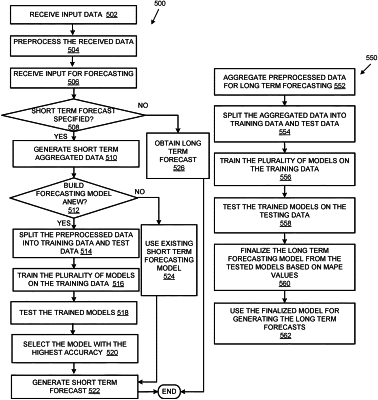| CPC G06N 5/02 (2013.01) [G06Q 10/06315 (2013.01); G06N 20/00 (2019.01)] | 18 Claims |

|
1. A resource data modeling and simulation system, comprising:
at least one processor;
a non-transitory processor-readable medium storing machine-readable instructions that cause the processor to:
receive historical time series data regarding data processing tasks and resources that are employed for handling the data processing tasks;
receive input regarding one of a short-term forecast and a long-term forecast to be generated, the short-term forecast and the long-term forecast pertaining to a number of the data processing tasks expected to be received in a corresponding one of a shorter time period and a longer time period;
if the input specifies the short-term forecast, then:
obtain short-term aggregated data by aggregating the time series data for the shorter time period;
generate updated short-term aggregated data including short-term aggregated data and aggregated data obtained from a time interval that elapsed since the short-term aggregated data was generated;
if an accuracy of an output of a prior short-term forecasting model falls within a predetermined accuracy threshold,
obtain the short-term forecast by employing the prior short-term forecasting model for analyzing the updated short-term aggregated data;
if an accuracy of the output of the prior short-term forecasting model falls outside the predetermined threshold,
obtain the short-term forecast by:
splitting the short-term aggregated data into training data and testing data,
training a plurality of forecasting models on the training data;
testing the plurality of forecasting models on the testing data;
comparing accuracies of the plurality of forecasting models; and
selecting as a new short-term forecasting model, one of the plurality of forecasting models with highest accuracy;
employing the new short-term forecasting model for analyzing the updated short-term aggregated data;
and
if the input requires the long-term forecast, then:
obtain long-term aggregated data by aggregating the time series data for the longer time period;
generate updated long-term aggregated data including the long-term aggregated data and aggregated data obtained from a time interval since the long-term aggregated data was generated and the specified time;
select a long-term forecasting model from a plurality of long-term forecasting models based on an accuracy of an output of the selected long-term forecasting model falling within the predetermined threshold;
obtain the long-term forecast by employing the selected long-term forecasting model for analyzing the updated long-term aggregated data;
calculate a number of resources required to handle the data processing tasks expected to be received in the corresponding one of the shorter time period and the longer time period; and
generate simulations for one or more parameters associated with the data processing tasks in response to simulation user input based at least on optimized values of one or more of the short-term forecast and the long-term forecast.
|